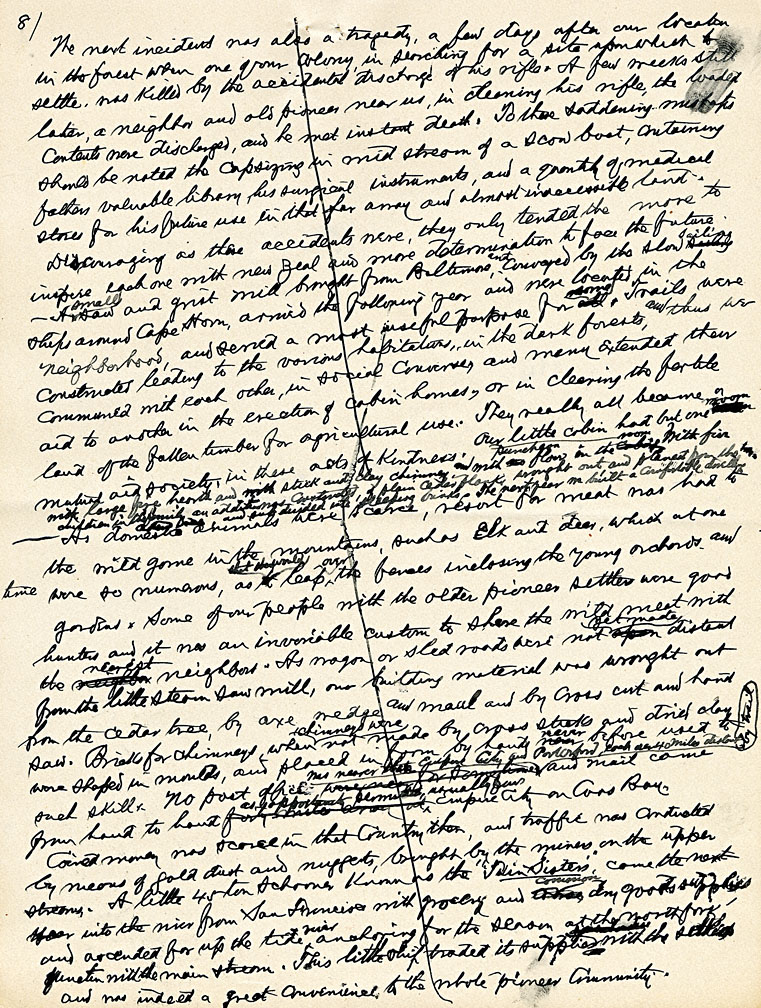- Catalog No. —
- Mss 743-1-8
- Date —
- c. 1910-1920
- Era —
- 1881-1920 (Industrialization and Progressive Reform)
- Themes —
- Oregon Trail and Resettlement
- Credits —
- Oregon Historical Society
- Regions —
- Coast
- Author —
- Binger Hermann
The Baltimore Colony
This hand-written document is an excerpt from the first draft of Binger Hermann’s (1843-1926) autobiography, titled “The Story of a Busy Life.” It describes pioneer life in the Coquille Valley during the late 1850s.
In April 1859, seven families and several single men left Baltimore, Maryland, hoping to build a new life in Oregon’s Coquille Valley. Known as the Baltimore Colony, this group of families was led by Henry Hermann, a German-born physician who wanted to escape the stresses of city life and find a more healthful life in the Far West. Shortly after arriving in the Coquille Valley, one of the Colony’s children fell from a boat and drowned. Henry Hermann’s sixteen-year-old son Binger almost met the same fate when he jumped in the water to try to save the boy. Soon afterward, another colonist accidentally killed himself with his rifle, the incident with which Binger Hermann opens in the excerpt reproduced above.
“Discouraging as the accidents were,” Hermann writes, “they only tended the more to inspire each one with new zeal and more determination to face the future.” The colonists chose home sites and began to immediately clear the land. Although eager to carve out a new life on the frontier, most of the colonists were inexperienced in pioneer life. There was but one farmer among them. Besides Hermann, a physician, there was a piano maker, a tinsmith, a music teacher, a cabinetmaker, a locksmith, and two cigar makers. Despite their inexperience, they managed to survive by helping one another out in what Hermann describes as a “mutual aid society.”
The small community of experienced pioneers already living in the valley also aided the Colony, particularly in hunting, a skill few of the city-born colonists had. Another Coquille Valley pioneer, Russell Dement, remarked that the colonists’ guns “were not suitable for large game, but there were a few of the earliest settlers that were from the backwoods states and had crossed the plains and brought with them Kentucky rifles. It was no trouble to keep the newcomers from the city in meat.”
Some of the colonists, discouraged by the hardships of pioneer life, moved to California or returned to Baltimore, but their numbers were soon replaced by new arrivals. Among those who stayed was the Hermann family. Binger Hermann would go on to a prominent career in politics, serving in the state legislature, as commissioner of the General Land Office, and in the U.S. House of Representatives.
Further Reading:
Dodge, Orvil. Pioneer History of Coos and Curry Counties, Oregon. Bandon, Oreg., 1969.
Jackson, E.R., ed. “After the Covered Wagons: Recollections of Russell C. and Ellis S. Dement.” Oregon Historical Quarterly 63, 1962: 5-40.
Peterson, Emil R., and Alfred Powers. A Century of Coos and Curry: History of Southwest Oregon. Coquille, Oreg., 1977.
Written by Cain Allen, © Oregon Historical Society, 2005.
